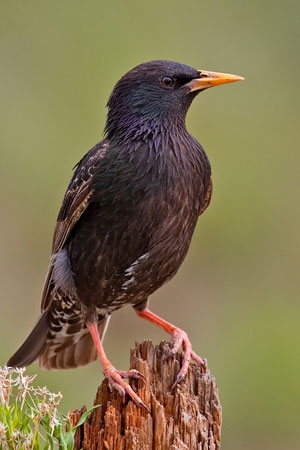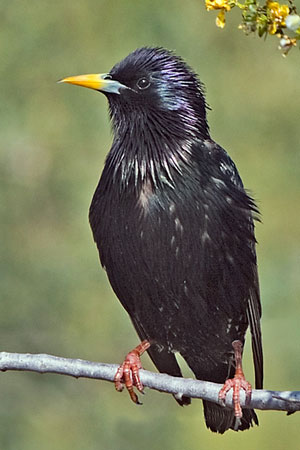

|
European Starling (Sturnus vulgaris) Description: European Starlings were purposefully introduced into North America in the 1890s. The European starling is a medium-sized, black songbird with short, triangular wings, speckled plumage, and a short tail. They are about six inches long - similar in size to the America Robin - with a pointed bill that is yellow, but becomes dark in the fall. 
The starling has a very colorful plumage. It is iridescence purplish-black on the head and on the chest. The wings have a green hue whereas the wing ending is brownish black. There are pale markings all over their body. The legs are pinkish red. Starlings molt their feathers in the fall. The new feather tips are whitish, giving the bird a speckled appearance. Over the winter sunlight and weather dulls the speckled look and the bird becomes uniform dark brown or black. Juveniles are drab gray-brown overall. Males and females look alike. Starlings belong to the family of birds which includes vocal mimics known as myna birds.
Calls:
The song is a rather quiet series of rattles and whistled notes, often containing mimicry of other bird species. Flight call a purring "prurrp."
All the European Starlings in North America descended from 100 birds released in New York's Central Park in the early 1890s by Eugene Schieffelin. He and his friends were determined to introduce into the US all of the animals mentioned in the works of William Shakespeare. While some of their attempts failed, not so with the starling. In 1890 they released a small flock of 60 starlings and the next year, 40 more starlings were released. Today, European Starlings range from Alaska to Florida and northern Mexico, and their population is estimated at over 200 million birds. Their range expanded to the midwest by 1930, reached the Rocky Mountains by 1940, and the west coast by the 1960’s (source: All About Birds) Uses a variety of habitats with open country, fields, and trees for nesting; especially near people in agricultural and urban areas. Click the range map to learn more about the distribution of the European Starling in Washington. Diet: The European Starling's diet consists of a variety of invertebrates, fruits, grains, seeds, and garbage. Starlings forage on lawns and other areas of short grass, such as pastures, golf courses, turf farms, and similar places. One of their very favorite foods is the large larva of the leatherjacket, or marsh cranefly (Tipula paludosa), which eats the roots of grass plants. 
Nesting: European Starlings typically produce two broods a year of four to seven young each. For nesting, adults usually use a woodpecker cavity or natural cavity in a tree, utility pole or fence post. This means Starlings may compete with native birds for nesting sites. Starlings will exploit any hole with a suitably sized interior cavity including dryer, range and bathroom vents. Starling nests built into any house cavity can accumulate material that is unsightly and could represent a fire hazard. Nests in cavity usually 10-25 ft above ground. The cavity is filled with grass, pine needles and other material, like feathers, paper, plastic, and string. Four to six slightly glossy, pale blue eggs hatch after an incubation period of 11 to 13 days. Starling eggs are about the same size, shape, and color as robin eggs. The young begin to fly at 18 to 21 days of age, and out-of-nest care by parents lasts 2 to 4 days. Behavior: Song is a rather quiet series of rattles and whistled notes, sometimes using mimicry of other bird species. Flight call a purring "prurrp." European Starlings are very noisy birds, especially in large groups. Starlings are attracted to both seed and suet feeders, and their aggressive habits can deplete food supplies and keep smaller birds from approaching.  European Starling Did you know?
More Information: European Starling - All About Birds European Starling - Chipper Woods Bird Observatory European Starling - WDFW Living with Wildlife Animal silhouettes available to purchase » Photos by Natures Pics; Mike R (eggs) Home | About Us | How to Participate | Biodiversity Modules | Projects | Maps | News | Resources |